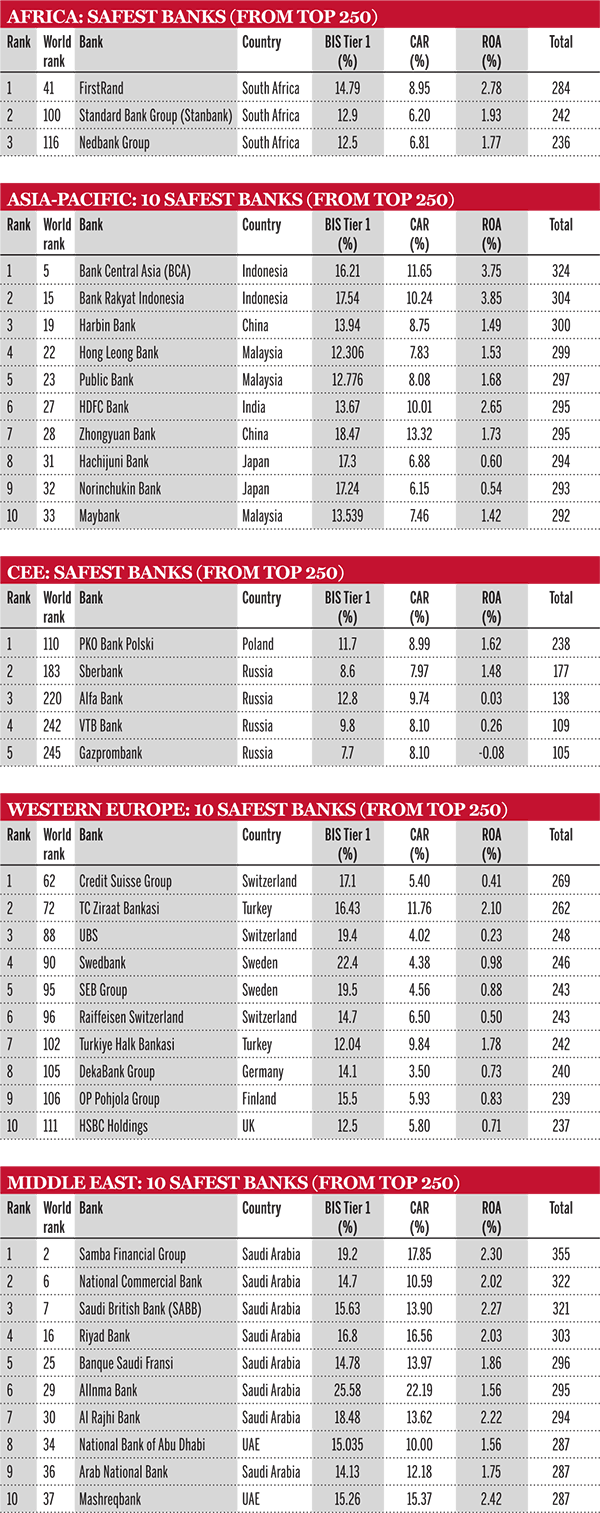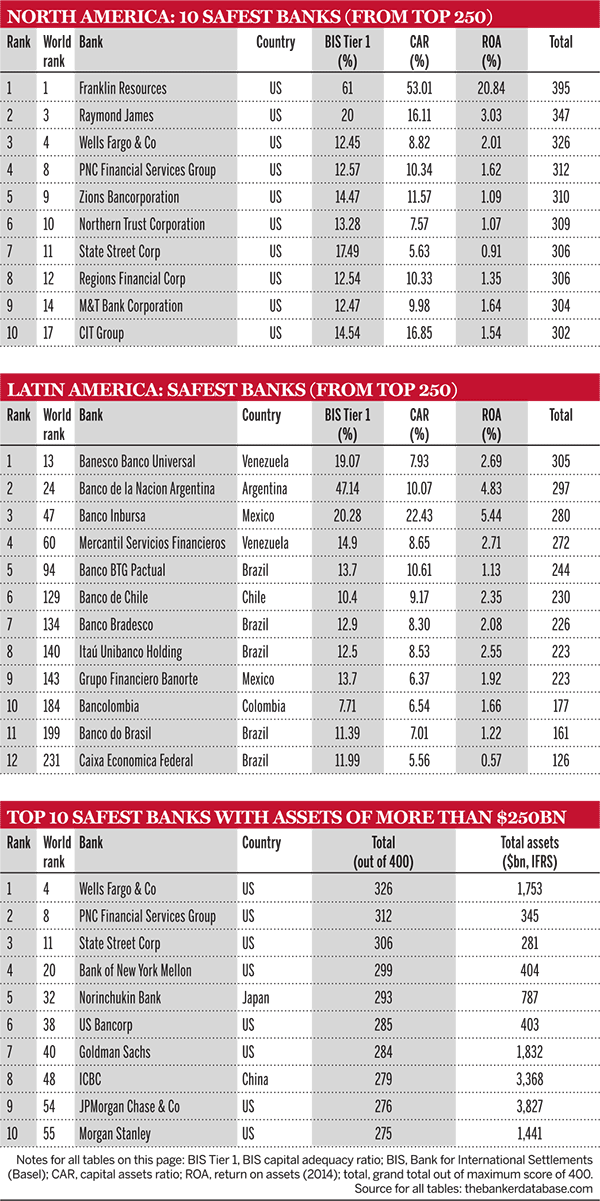Introducing The Banker's Top 250 Bank Safety Ranking
The Banker's Bank Safety Ranking, which analyses the world's largest 250 banks based on characteristics that help identify their financial stability, shows the Gulf states performing well, while the eurozone periphery remains weak.
As the financial crisis showed so vividly, size alone is no guarantee of safety. The Banker therefore decided to choose from the huge range of fields available in The Banker Database some key data points that can give a true indication of the likely safety and stability of a banking group.
In total, there are more than 5000 banks in The Banker Database, and the safest of these might be very small. Given the importance of the largest banks for the stability of the global financial system, however, we have chosen to apply our methodology to the largest 250 banks in the world by Tier 1 capital. These institutions represent $98,000bn of total assets from 48 countries (87% of the aggregate assets from the Top 1000 World Banks), and $5500bn of Tier 1 capital (80% of the Top 1000), as of the end of 2014.
The fact that the proportion of total capital represented by the top 250 is less than the proportion of assets suggests that smaller banks outside the top 250 may indeed be better capitalised. However, this is just one measure of safety. We have also looked at asset quality, profitability, how the bank funds itself, and the risk environment for each bank’s home country. We hope to refine this methodology in future years by looking at longer time series for profitability – to judge if those profits are sustainable – and for asset quality. In particular, this should provide a sense of whether asset quality is improving or deteriorating.
The country risk environment is the one data point for which we have to rely on an outside source. We have used the country risk classification from the Organisation for Economic Co-operation and Development (OECD). This is an internationally recognised and trusted measure of the risk of providing export credit to importers based in that country. As such, it is a good proxy for some of the key components of the financial risk environment, including the danger that access to foreign currency might be curtailed and the threat of civil conflict.
Specialist versus universal
The first noticeable trend in The Banker's Bank Safety Ranking is the strong performance of asset managers with a banking licence, or banks that specialise in custodial services for investors. These include well-known US institutions such as Franklin Resources – at the top of the ranking – or State Street, coming in at 11. These companies take very little market or credit risk of their own, since the risk of loss lies with the end-investors that they serve. Consequently, they naturally perform far better than most banks in terms of BIS ratios and asset quality.
The disproportionate strength of asset managers when compared with banks in this way rather confirms the reasoning behind the industry’s strong objection to the idea of designating the largest players in asset management as global systemically important financial institutions (SIFIs). The Financial Stability Board (FSB) has already applied this global SIFI designation to 30 banks – all featured in this safety ranking. But in June 2015, the FSB’s partner in the asset manager SIFI project, the International Organisation of Securities Commissions, announced that it was postponing the designation process, to focus instead on specific activities within asset management that might pose systemic risks.
Among the genuine universal banking groups, capital ratios are especially strong in the Gulf states, and especially Saudi Arabia. What is noticeable is that while many US banks perform well in terms of their BIS ratios – which use a process of risk-weighting assets – they are less strong using the unweighted capital-to-assets ratio. This is because the risk weights assigned tend to be lower than for Gulf banks, many of which have very similar BIS and capital-to-assets ratios. We have often noted that capital-to-asset ratios for the larger US banks can be flattered by reporting in generally agreed accounting principles, which allow netting of derivative positions. By contrast, more widely used international financial reporting standards (IFRS) require the reporting of derivative positions to be on a gross basis. To permit better international comparability of the capital-to-assets ratio data, we have used estimates of US banks’ IFRS balance sheets published by the Federal Deposit Insurance Corporation.
Risky business
At the risky end of the spectrum, it will surprise no one who has followed the eurozone crisis since 2010 to find a range of banks from the eurozone periphery. Bottom of the list is Italy’s Monte dei Paschi di Siena, but of course this is based on its end-2014 financial position. In June 2015, Monte dei Paschi raised €3bn in fresh capital, and its score in next year’s safety ranking should benefit as a result.
By contrast, Greek banks that were comparatively well capitalised after a 2013 rescue package have been heading in the opposite direction in 2015. Prolonged uncertainty over the country’s eurozone status has caused sharp falls in asset quality and massive deposit outflows that will radically worsen their loan-to-deposit ratios for this year. The country’s new bail-out is mooted to include as much as €25bn to put its banks back on an even keel.
Another country that has experienced sharp macroeconomic decline recently is Russia, where the exchange rate fell heavily in the final quarter of 2014. This could lead to a sharp deterioration in asset quality for clients who borrowed in hard currency, but the effects have not yet fed through to banking results – impairments would usually be taken only on loans more than 90 days overdue.
One interesting phenomenon is the relatively strong showing from banks in two countries that have the worst OECD country risk scores – Venezuela and Argentina. The banks in these countries show relatively high capital ratios, but also strong profitability. However, these profits are generated mainly by lending to state-linked entities in a high-inflation and budget-deficit environment that might not be sustainable. While our safety ranking can capture the headline risks, there is an additional layer of microprudential assessment on items such as borrower concentration risk that we cannot yet fully represent here.
How we did it
The methodology for this ranking is based on seven indicators that assess bank's capital adequacy, asset quality, liquidity, risk environment and profitability based on their latest audited year-end financials. We have included in our analysis the top 250 world banks 2015 in terms of Tier 1 capital. We have also included the capital-to-assets ratio, the tier 1 BIS ratio, the ratio of total impairment charges to total operating income, and the return on assets from The Banker Database. In addition, we have used the country risk classification (CRC) score from the OECD as a proxy for the risk environment in the bank’s home country. The indicators used are the following:
Capital adequacy
- Capital-to-assets ratio for the latest financial year-end.
- Tier 1 BIS ratio for the latest financial year-end.
Asset quality
- Total impairment charges to total operating income for the latest financial year-end.
- Total impairment charges to total operating income averaged over the past two years.
Liquidity
- Loan-to-deposit ratio for the latest financial year-end.
Risk environment
- CRC from the OECD, recalculated from seven to five risk buckets.
Profitability
- Aggregate return on assets over the past two years.
- Return on assets for the latest financial year-end.
We have ranked each bank based on each indicator, and broken down our sample into 50 buckets, the highest score attributed being 50 and the lowest score being one. The scores are then aggregated on equal weights. The maximum possible score is 400.
The Banker's Top 250 Bank Safety Ranking originally appeared in the September 2015 issue of the magazine. The full results of the ranking are available on The Banker Database. Find out more about the database, register for a free trial or subscribe today.




